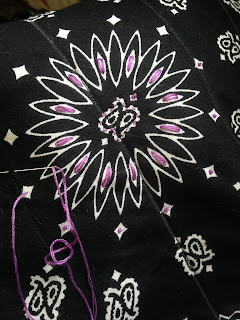Hi Everyone. I'm sure that most of you sewer's out there has a tomato pin-cushion. I remember when my Mama put together my first little sewing kit for me. In there was this pretty red tomato pin cushion with pins already stuck in it. I had seen her's and thought that it was a really neat thing to stick her pin's in. Now I had my own and I was so excited. When my best friend came over to sew with me, I couldn't wait to show her my very own tomato pin-cushion. As I remember, she was quite impressed. Mama was teaching both of us how to do embroidery and how to make clothes for our Ginger dolls. We all had so much fun that afternoon sewing. I felt so grown up with my own tomato pin-cushion. After my Mama passed away, I was going thru some of her sewing things and came across this little pin-cushion still in the original package. Yup, that was my Mama, she loved to tuck things away and then forget she had them. Well, I thought about not opening it and just saving it as it was, but I decided I should go ahead and use it. I think of Mama every time I use it and often of that afternoon, when I was about 7 years old, and sewing with her and my best friend.
I got to thinking the other day, wow, the tomato pin-cushions have been around a very long time. Well, when I got to doing some research on them, come to find out they have been around since the 15th century!
The first reference to the tomato pin-cushion appears in the 15th century. Before this, as metal pins were rare and expensive, they were stored in a variety of protective cases made of bone, ivory or silver. During the Tudor Era (1485-1603) it became common practice to use fancy, stuffed shapes to store needles and pins. The familiar tomato shape evolved due to the folklore surrounding the fruit, which symbolized prosperity and repelled evil spirits.
A custom revolved whereby ripe tomatoes were placed on the mantel to ensure future prosperity. As real tomatoes were not always available, people created fabric tomatoes stuffed with sand or sawdust. Eventually, the stuffed, decorative tomatoes were used as pin cushions.
The stuffed tomato pin-cushion was further popularized in the Victorian Era. As parlor rooms became more opulent the lady of the house displayed collections of pin cushions in various shapes (fans, dolls, shoes, fruits and vegetables, taking pride in their number and variety. The tomato pin-cushion became a familiar presence.
In the early 1700's pin pillows came into use, the predecessor of the pin-cushions of today. They were beautifully made from fine fabrics and often delicately embroidered.
Soon the pin pillows became mounted on a silver, china or wooden stand or base.
As years went by, in many cases the pin-cushions became more common as a useful, functional sewing aid.
Article taken from Threads - for people who love to sew
It was fun learning how this very popular and very long lived pin-cushion came to be. Now, if one of your sewing friends ever asks you if you know anything about the tomato pin-cushions, you will be able to tell them all about them.
Blessings to all









































